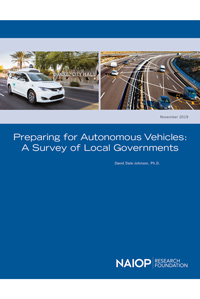Autonomous Vehicles Are Down the Road, But Where Will They Park?

Parking facilities could stay roughly the same size as they are today, but with significant redesigns.
While the timeline regarding the implementation of personal automated vehicles (AVs) is highly uncertain, it appears likely that driverless taxis, transit and goods delivery could soon be a widespread reality. During the past 90-plus years, the built environment has largely been shaped by the automobile. However, according to UCLA urban planning professor Donald Shoup in his book “The High Cost of Free Parking,” almost all privately owned automobiles are parked 95% of the time. So, what impact will AVs have on parking infrastructure?
Driverless Vehicles Mimic Drivers
Though most parking concepts for AVs focus on parking that optimizes curb space, will AVs park at facilities at all? Current driver behaviors may help answer that question. In suburban environments, conventional taxis with drivers tend to park where they expect demand. In dense urban environments, most drivers travel around looking for fares.
Driver behavior at transportation network companies (TNCs) like Uber and Lyft follows a similar pattern: some stay put until a fare appears, while others continue to circulate. While pilot deployments of AV taxis are limited to certain areas today, AVs will likely behave in the same manner — parking at common demand spots or driving around until hailed.
AVs Take Charge
If the division of parked and circulating AVs follows the pattern of human-driven taxis, it will be strongly influenced by where AVs can be charged or refueled. For example, undercarriage charging, which is a wireless method for rapidly re-energizing a car’s batteries that doesn’t require precision docking or a human attendant to plug the AV into a charging station, is likely to become important in the future.
Some AV transit concepts feature very low-capacity batteries since they can be charged incrementally at stops. In the future, there may be more emphasis on short-burst charging for AV taxis at the curb vs. 300-mile-range megabatteries, which are designed to minimize driver anxiety for personally owned electric vehicles (EV).
In-line inductive charging, in which the electrical current is transported magnetically, could be a popular wireless charging approach, but it may not work at scale since it would require embedding electronics and wiring in roads, or using new concrete mixtures with magnetic ferrites or graphene as aggregates. This would also be additional infrastructure for public agencies to maintain. While the technology is being actively researched with a handful of successful operational demonstrations around the world, in-line inductive charging is still far from a proven long-term solution. Because of that, it seems likely that AVs will have to park somewhere temporarily to recharge to operate efficiently during the next decade or beyond.
AV Fleets as Amenities
In the future, apartment buildings and condominiums may offer AV fleets as amenities, but building owners will likely not own the vehicles. Like traditional rental cars, AVs will get worn out quickly, so they will probably be leased from an AV service provider.
Multifamily developments will have to decide how many AVs to offer and create policies for their use. For example, will AVs be available first-come, first-serve, or will reservations or subscriptions be required? If the building pivots from assigned paid parking spaces to parking for fleet AVs, will fewer parking spaces be needed?
Parking the Fleets
Unless a gig-economy concept is invented that services cars at their distributed resting spots, it’s likely AVs would return to a mothership facility operated by the service provider for cleaning, repairs and recharging before being dispatched to customers the next day.
The same number of vehicles will be needed to take tenants to their workplaces in the morning and then return them home in the evening. Peak demands for travel won’t change much even if working from home remains popular in the aftermath of COVID-19. For this reason, vehicle miles traveled (VMT) is more likely to go up with AVs, not down. This may not be the case if ridesharing becomes incredibly popular, but not everyone is open to the carpooling options that TNCs offer.
Imagine a building in which 100% of the tenants use the AV service; 50% pay a premium to have their own AVs and the other 50% opt for ridesharing. Parking AVs nose-to-tail may allow for more vehicles in the same amount of parking space, but a larger ingress and egress area would be needed for tenants to access the AVs in an orderly fashion. Overall, the parking footprint of a building like the one in this scenario is unlikely to decrease substantially because of AV services.
Retail and Short-Term Parking
Destination parking for retail and other short-term needs could probably be significantly reduced. Still, would the user be owning the AV for personal use, renting the same AV for several hours (like a ZipCar or Car2Go), or is a different AV bringing them home from their destination (like a traditional taxi or TNC)?
Multiple business models will likely be available to meet the needs of customers, so parking will probably evolve into a combination of pick-up and drop-off areas and traditional spaces.
Helping AVs Navigate Parking Lots
Once an AV has reached a parking lot, how will it find its way around? Will it use wayfinding beacons or GPS? This is a tactical problem that could pose a significant challenge.
Parking concepts with nose-to-tail storage have minimal space between each row of AVs, meaning there’s little room for error. GPS does not work very well indoors or in underground facilities. While native sensors on an AV may help it line up precisely in the correct spot, knowing where to go is perhaps a different story.
Accomplishing this may require the vehicle to store a map of the garage, or for map data to be transmitted to the AV when it enters the facility.
SAE International, a standards-developing organization, has defined a standard for a 2-D signal-controlled intersection Map Data (MAP) as part of its J2735 Standard for Dedicated Short Range Communications for Wireless Access in Vehicular Environments (DSRC/WAVE). This standard helps connected and automated vehicles interpret traffic signal information and navigate signalized intersections safely. More complicated geometric descriptions have not been specified in the standards to date, such as the presence of gates, RFID readers, space restrictions and similar obstacles. Garages are also frequently 3-D spaces, so standards from other technology areas such as gaming or building information modeling (BIM) will likely be necessary.
While demonstrations of AVs automatically parking have been around for a few years now, there is still much technical work to be done to make such operations work at scale.
Looking Ahead
Though much of the driverless future is unknown, it is not too soon to consider the parking infrastructure needed for its widespread introduction to succeed. Understanding driverless behaviors, and if and how AVs will park at facilities, is essential when planning for future parking infrastructure. How the AVs will charge and refuel is also an important consideration, as AVs will likely have to park somewhere at least temporarily to recharge.
In the future, if apartment buildings and condos offer AV fleets as an amenity, they should prepare to have their parking footprints stay relatively the same but with significant redesigns of how that space is used. In contrast, destination parking for retail and short-term purposes may decrease, but AVs may have trouble navigating parking lots, particularly underground and multistory facilities.
With a forward-thinking mindset, developers and investors who understand parking infrastructure for autonomous vehicles will stay ahead of the fleet.
Douglas Gettman, Ph.D., is a Smart Mobility and AV/CV Senior Consultant at Kimley-Horn.
Relevant Research

In November 2019, the NAIOP Research Foundation published “Preparing for Autonomous Vehicles: A Survey of Local Governments.” The report, by NAIOP Research Foundation Distinguished Fellow David Dale-Johnson, Ph.D., the Stan Melton Executive Professor of Real Estate at the Alberta School of Business at the University of Alberta, examines how local governments are preparing for fully autonomous vehicles and explores how future AV-related policies could affect the commercial real estate industry. The author interviewed eight community leaders from local governments in the U.S., Canada and Australia and reviewed recent secondary sources to identify significant trends in AV development and related municipal policies.
To learn more or to download the report, visit: www.naiop.org/en/Research-and-Publications/Reports/Preparing-for-Autonomous-Vehicles




